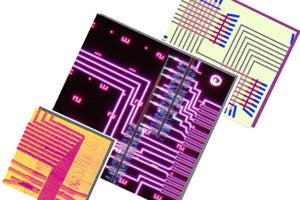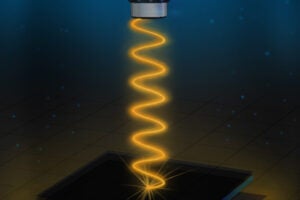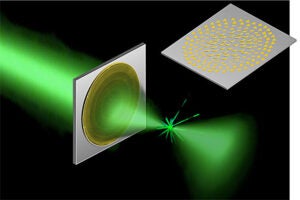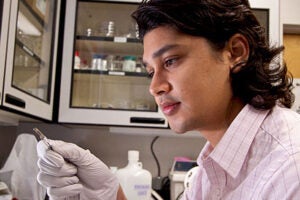Tag: Caroline Perry
-
Nation & World
Robot hands gain a gentler touch
Researchers at the Harvard School of Engineering and Applied Sciences have developed an inexpensive tactile sensor for robotic hands that is sensitive enough to turn a brute machine into a dexterous manipulator.
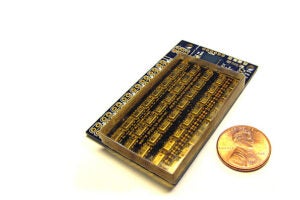
-
Nation & World
Imagining impact, and believing in it
Sixth annual Harvard College Innovation Challenge supports student projects through a year of development and beyond. From common roots — intellectual curiosity and the desire to make life just a little bit easier — 64 ideas blossomed this year in the challenge.
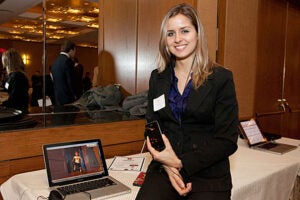
-
Nation & World
Applied physics as art
Harvard researchers spray-paint ultrathin coatings that change color with only a few atoms’ difference in thickness.
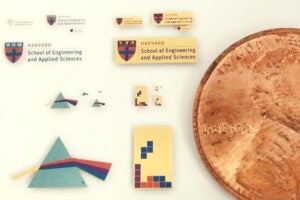
-
Nation & World
Pecking order
Harvard researchers have found that a new investigation of tissues and signaling pathways in finches’ beaks reveals surprising flexibility in the birds’ evolutionary tool kit.
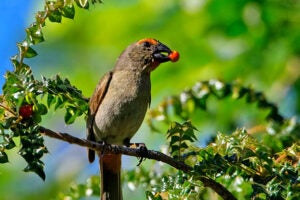
-
Nation & World
Needle beam stays on point
A Harvard-led team of researchers has demonstrated a new type of light beam that propagates without spreading outward, remaining very narrow and controlled along an unprecedented distance. It could greatly reduce signal loss for on-chip optical systems and may eventually assist the development of a more powerful class of microprocessors.
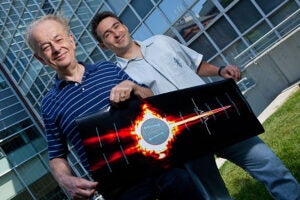
-
Nation & World
Super gel
A team of experts in mechanics, materials science, and tissue engineering at Harvard has created an extremely stretchy and tough gel that may suggest a new method for replacing damaged cartilage in human joints.
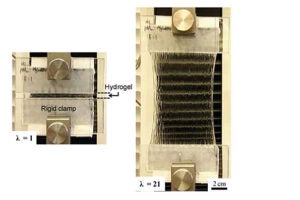
-
Nation & World
Clues in the cucumber’s climb
Harvard researchers, captivated by a strange coiling behavior in the grasping tendrils of the cucumber plant, have characterized a new type of spring that is soft when pulled gently and stiff when pulled strongly.
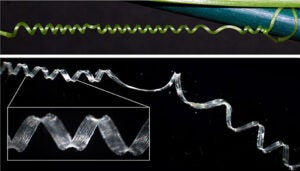
-
Nation & World
Action figures come to life
A group of graphics experts led by computer scientists at Harvard have created an add-on software tool that translates video game characters — or any other three-dimensional animations — into fully articulated action figures, with the help of a 3-D printer.
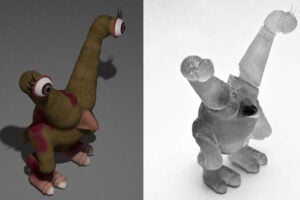
-
Nation & World
Carbon counter
Atmospheric scientists at the Harvard School of Engineering and Applied Sciences (SEAS) and Nanjing University have produced the first “bottom-up” estimates of China’s carbon dioxide (CO2) emissions, for 2005 to 2009, and the first statistically rigorous estimates of the uncertainties surrounding China’s CO2 emissions.
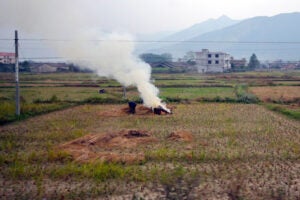
-
Nation & World
Fuel cell keeps going after hydrogen runs out
Materials scientists at Harvard have demonstrated that a solid-oxide fuel cell (SOFC), which converts hydrogen into electricity, can also store electrochemical energy like a battery. This fuel cell can continue to produce power for a short time after its fuel has run out.
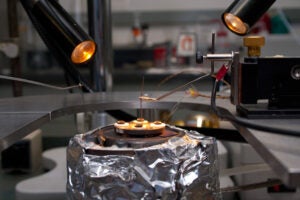
-
Nation & World
Touch, drag, learn
Research by computer scientists, biologists, and cognitive psychologists at Harvard, Northwestern, Wellesley, and Tufts suggests that collaborative touch-screen games have value beyond play.
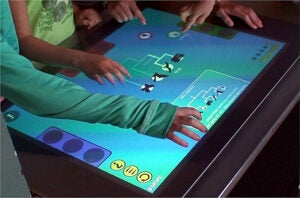
-
Nation & World
Meticulous design
A recent SEAS workshop emphasized comprehensive planning, cultural awareness, and a holistic approach to design in developing solutions to global problems.
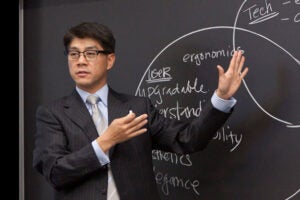
-
Nation & World
Sharing design, in all its forms
The first Design Fair at the Harvard School of Engineering and Applied Sciences (SEAS) displayed the wealth of ideas that have emerged at SEAS throughout this past academic year.
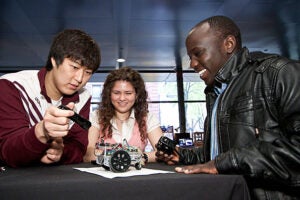
-
Nation & World
‘Warming hole’ delayed climate change
Climate scientists at the Harvard School of Engineering and Applied Sciences (SEAS) have discovered that particulate pollution in the late 20th century created a “warming hole” over the eastern United States — that is, a cold patch where the effects of global warming were temporarily obscured.

-
Nation & World
Ideas galore
Students participating in the Harvard College Innovation (I3) Challenge this year generated dozens of promising ideas to improve the quality of daily life.
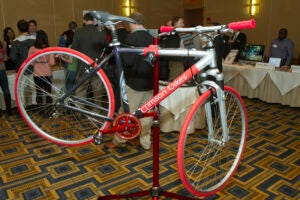
-
Nation & World
Nurturing the seeds of innovation
The bond between Harvard and Silicon Valley is a close one. The region is home to a powerful network of alumni willing to offer mentorship to students and recent graduates who are dreaming big. Taking advantage of that network, SEAS and HBS recently came together to organize the trip to Palo Alto.
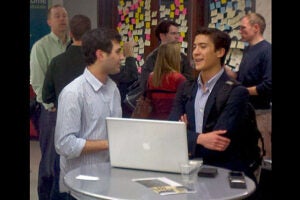
-
Nation & World
Model situation?
Researchers at the Harvard School of Engineering and Applied Sciences (SEAS) have shown that the primary explanation for the reduction in CO2 emissions from power generation that year was that a decrease in the price of natural gas reduced the industry’s reliance on coal.

-
Nation & World
Street smarts
Students develop hurricane response plans on Cambridge roads, gaining practical experience in computational science competition, ComputeFest, a two-week program hosted by the recently created Institute for Applied Computational Science within the Harvard School of Engineering and Applied Sciences.
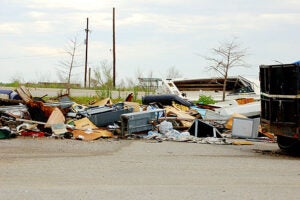
-
Nation & World
Physics at 2,500 feet
In 1934, a group of enterprising young Turks pooled their money and bought construction plans for a glider. Pioneers in the infancy of aviation, they built it by hand, out of wood and fabric, and when the time came for its maiden flight, they drew straws.
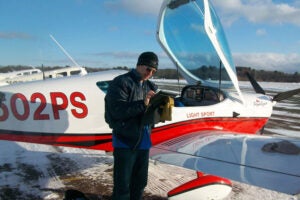
-
Nation & World
Crowdsourcing nutrition in a snap
Harvard School of Engineering and Applied Sciences’ PlateMate project proves that a well-managed crowd can play the role of a trained nutritionist.
-
Nation & World
You’re not so anonymous
Prescription data stripped of identify information seems not so anonymous after all. Researcher Latanya Sweeney aims to make such personal data more secure and to provide recourse for people who are harmed by privacy breaches.
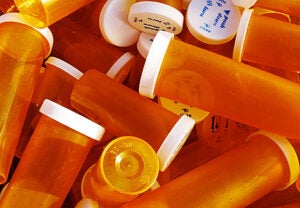
-
Nation & World
Surgical precision
In ES 227, “Medical Device Design,” SEAS students are given the opportunity to solve practical problems in a hospital setting, trying out the tools, learning about their use in real-world situations, and, in some cases, even sitting in on surgical procedures.
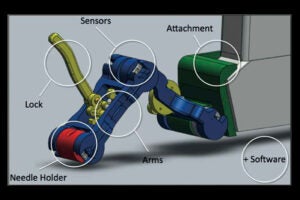
-
Nation & World
What’s in a liquid
New 3-D nanostructured chip identifies unknown liquids instantly, offering a litmus test for surface tension.
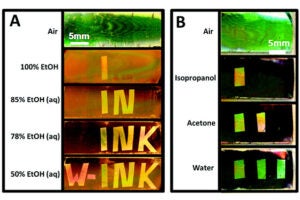
-
Nation & World
Pollock: Artist and physicist?
A quantitative analysis of the streams, drips, and coils of artist Jackson Pollock by a Harvard mathematician and others reveals that he had to be slow and deliberate to exploit fluid dynamics as he did.
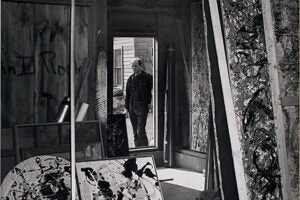
-
Nation & World
Tut, tut!
Ralph Mitchell, a Harvard professor and authority on cultural heritage microbiology, investigates “fingerprints” left on the walls of Egyptian King Tutankhamen’s tomb by ancient microbes.

-
Nation & World
Matching supply, demand
Harvard graduate student Wonyoung Kim has developed and demonstrated a new device with the potential to reduce the power usage of modern processing chips.
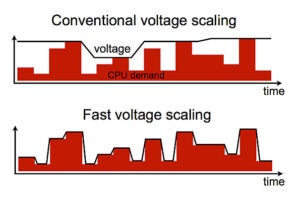
-
Nation & World
What ultra-tiny nanocircuits can do
Engineers and scientists collaborating at Harvard University and the MITRE Corp. have developed and demonstrated the world’s first programmable nanoprocessor.
